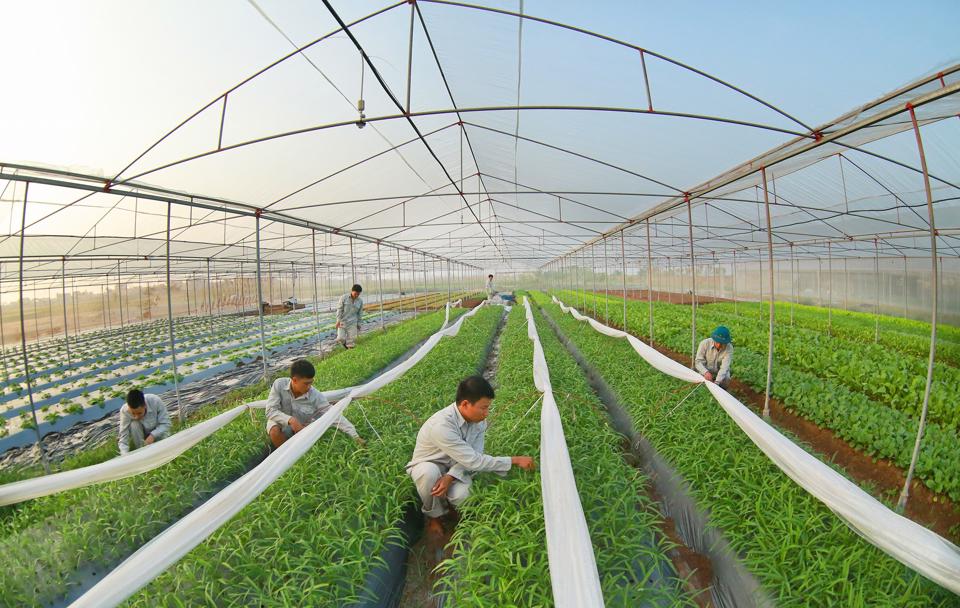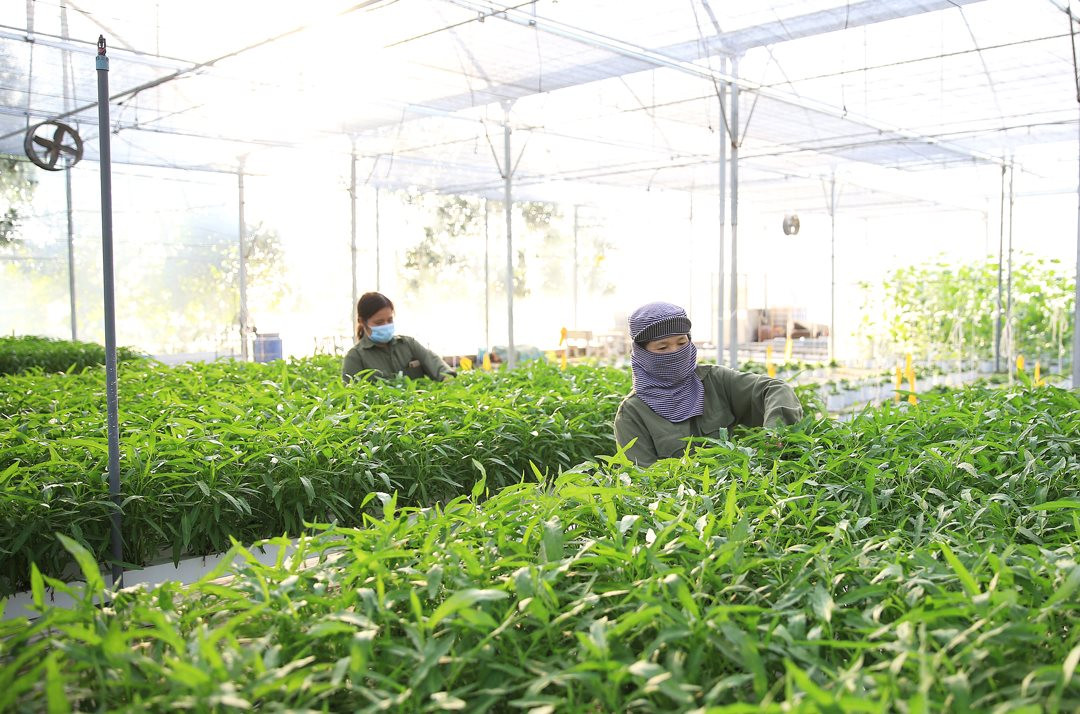
With the impressive growth rate seen in the first half of the year, local insiders are optimistic that the capital's agricultural sector is not only on track to meet the targets set for this year, but could very well exceed them, making it worthy of being the backbone of the capital's economy.
Growth in most areas
| Clean production at the Japan & Vietnam Vegetable Fruit Company. Photo: Phuong Nga/The Hanoi Times |
Despite significant risks from weather, natural disasters and disease, Hanoi's agricultural sector has maintained growth in almost all areas.
The total production value of agriculture, forestry and fishery in the first half of 2024 reached over VND22.6 trillion ($891.7 million), an increase of 2.9% compared to the same period last year. Specifically, agricultural production accounted for VND20.9 trillion ($827 million) (up 2.9%), while fishery production reached VND1.67 trillion ($66 million) (up 3.3%).
Hoang Thi Hoa, Director of the Hanoi Agricultural Development Center, emphasized that optimism stems from innovative production strategies and the integration of advanced technology in various models. It is noteworthy that 80% of the rice area is now planted with high-value varieties while concerted efforts are being made to expand the cultivation of fruits and medicinal plants.
She added that the area dedicated to safe and organic vegetables in Hanoi is also growing, supplying not only the local market but also reaching many other provinces.
Aquaculture areas continue to develop in a sustainable and safe way, using high-tech methods. The area for aquaculture in Hanoi covers 22,600 hectares, an increase of 2.5%, yielding fishery output in the first half of 2024 of 10,900 tons, up 3.5% from the same period in 2023, according to the director.
Dong Anh District has supported the establishment of an electronic trading platform for local producers, enhancing management and product coding to ensure traceability and boost market competitiveness for agricultural products, Hoang Hai Dang, Deputy Chairman of the Dong Anh District People's Committee, told Hanoimoi Newspaper.
Nguyen Xuan Dai, Director of the Hanoi Department of Agriculture and Rural Development, affirmed that Hanoi's agricultural sector has successfully built a robust market economy driven by demand and innovative value chain models. In particular, many households are using digital technology to trade, a shift that plays a critical role in driving sustainable growth.
"The market is the key determinant of the value of any product, and increasing that value is a key focus for the agricultural sector. Although Hanoi has a vast agricultural production area, many farms remain small-scale. Therefore, we need to take advantage of market opportunities to achieve sustainable growth," he stressed.
Striving to surpass goals
| A high-tech vegetable production model is applied in Yen My commune, Thanh Tri district. Photo: Hanoimoi Newspaper |
Typhoon No. 2's heavy rains at the end of July damaged 243 hectares of corn and vegetables in addition to over 1,100 hectares of rice and 407 hectares of aquaculture in various parts of Hanoi. The risk of flooding in the city remains a concern through the end of 2024, along with significant market volatility affecting the agricultural sector.
Despite these challenges, the city's agricultural sector is committed to exceeding its targeted growth of over 3%.
Xuan Dai said that following the floods, the sector is assessing the damage and devising strategies to rebuild the affected rice, vegetable and fishery areas.
Areas at high risk of flooding will select short-duration vegetable varieties and use intercropping strategies while staying on top of weather and disease forecasts.
"From now until the end of the year, many high-value crops will be harvested and there will be an increase in meat and egg production. The agricultural sector is reviewing and supporting models that focus on processed products to add value," he added, "We are also working with the industrial sector to organize trade fairs and establish an e-commerce platform."
Luu Thi Hang, director of the Hanoi Plant Protection Sub-Department, said they are monitoring seasonal pests that may emerge and will conduct inspections to improve forecasting in this area.
"Municipalities, producers, companies and cooperatives must actively apply scientific and technological advances in production and wisely manage water resources for crops. Regular monitoring of weather conditions is essential to develop timely response strategies," she emphasized.
Nguyen Trong Khien, Vice Chairman of Thanh Oai District People's Committee: Transitioning to an industrial model for crop and livestock productionFrom now until the end of 2024, we are dedicated to boosting trade promotion for its agricultural products. In addition to organizing fairs and exhibitions, the district is working with various departments to train local producers, cooperatives and businesses in digital technology, establish trading platforms and showcase their products online. In November and December, we plan to work with the Municipal Department of Industry and Commerce and the Department of Agriculture and Rural Development to hold two or three agricultural product fairs, featuring OCOP (One Commune One Product) offers. To ensure sustainable growth, the district will effectively manage agricultural development planning and research policies to support agricultural product development. We are also reviewing and removing regulatory barriers to create an enabling environment to attract more investors, particularly in high-tech agriculture. There will also be a focus on transforming crop and livestock structures into an industrial model that meets market needs and local advantages. Bui Cong Than, Vice Chairman of Thuong Tin District People's Committee: Developing appropriate production and planting plansWith forecasts of significant and complex rainfall and storms, we have instructed localities to assess flood-prone areas to develop appropriate production and planting strategies. In areas vulnerable to flooding, communities should avoid planting long-term crops or aquaculture, and instead focus on growing vegetables and ornamental plants for the year-end market. For livestock, local authorities are inspecting farms, cooperatives and households to ensure effective vaccination and disease control. As the rice harvest approaches and storms loom, specialized units must guide farmers to take advantage of favorable weather windows by mobilizing labor and equipment to quickly harvest ripe rice fields and mitigate losses from rain and flooding. In addition, a concerted effort should be made to plant crops according to the optimal planting schedule. In the coming period, localities will continue to implement high-tech agricultural models and projects, emphasizing a shift from quantity to quality in agricultural production. Nguyen Dinh Tuong, Director of Dong Tam Livestock and Service Cooperative (Quoc Oai District): Boosting production of high-quality productsAs the year draws to a close, demand for food, especially pork and pork products, is increasing. In order to meet the market needs from now until the end of the year, we have been expanding our pig herd since March, focusing on processed products to meet consumer preferences. Each month, we supply between 13 and 15 tons of organic pork and various processed meat products such as sausages and traditional pork rolls. Our cooperative maintains a reliable supply chain through retail shops, restaurants and canteens in Quoc Oai district, as well as in the city and some supermarkets. Looking ahead, it's crucial to address market dynamics to ensure sustainable growth. We aim to not only produce high quality products, but also specialize in processing. Although we have developed a website to showcase and sell our products, its impact has been limited. Therefore, we hope to receive support from relevant departments to improve our digital technology for product distribution and move toward a more professional business model. |






- Prime Minister sets $70 billion export goal for agriculture by 2025
- Hanoi promotes circular agriculture through technology transfer
- OCOP products from across Vietnam on display at Hanoi fair
- OCOP and agricultural products promotion week underway in Hanoi suburb
- Vietnamese Gen Z's green mission
- Hanoi's flower villages are in full Tet preparation mode


